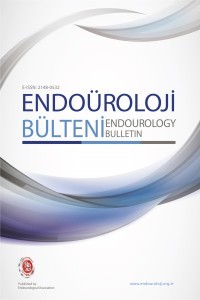Asistan gözüyle Türkiye’de retrograd intrarenal cerrahi ve perkütan nefrolitotomi eğitimi; ESRU Türkiye anketi
Amaç: Çalışmamızda retrograd intrarenal cerrahi (RIRS)/perkütan nefrolitotomi (PCNL) konusunda Türk üroloji asistanlarının yeterlilikleri, tercih ettikleri eğitim yöntemleri ve uygulanmakta olan eğitim modelleri oluşturulan anket ile sorgulanmış ve sunulmuştur.Gereç ve Yöntemler: Anketimizde eğitimde kullanılan yöntemler, eğitimin yeterliliği ve eğitim konusundaki beklentiler odak noktası olarak belirlendi. ESRU veritabanına kayıtlı olan toplamda 295 asistana gönderilen anketler toplamda 70 (%23) asistan tarafından yanıtlandı. Anketlerin oluşturulması ve dağıtımında SurveyMonkey kullanıldı.Bulgular: Anketimize en fazla katılım Marmara Bölgesinden (%39,29), en düşük katılım ise Güneydoğu Anadolu Bölgesi’nden (%5,36) gerçekleşti. Anketimize katılan 1. 2. 3. 4. ve 5. yıl asistanlarının oranı sırasıyla %14, %23, %23, %12,7 ve %25 olarak belirlendi. Eğitim araştırma hastanesi ve üniversite hastanesi katılım oranları sırasıyla %46,77 ve %53,23 olarak saptandı. Asistanların %10,94’ünün PCNL için %14,06’sının da RIRS için kendilerini bu cerrahileri uygulamak konusunda yetersiz hissettikleri belirlendi. Asistanların vakalara katılım oranları ise RIRS ve PCNL için sırasıyla; primer cerrah olarak %56 ve %50 , primer asistan olarak %25 ve %42,19 , izleyici olarak %4 ve %7,81 şeklinde gözlendi.Grubun %46,8’inin her iki cerrahi için de %15,63’ünün sadece PCNL için %15,63’ünün sadece RIRS için kurslara katılmak istediği saptandı. Kurslara katılabilen asistan oranının ise RIRS ve PCNL için sırasıyla %9,34 ve %1,56 olduğu görüldü. Her iki konuda da kurs alabilen asistanların oranı ise %4,69 olarak belirlendi. Grubun %40,63’ünün kursa katılamaması ile alakalı “klinik içi iş yoğunluğunu” %15,63’ünün kontenjanların yetersiz oluşunu, %18,75’inin asistanların yeterince desteklenmemesini, %14,06’sının kursların bulundukları bölgeye uzak oluşunu esas problem olarak gördüğü belirlendi. Sonuç: PCNL ve RIRS Türkiye genelinde yaygın olarak uygulanan endoürolojik cerrahilerdir. Asistanların bu cerrahi prosedürler için eğitimde önemli gördüğü kursların yaygınlaştırılmasının ve asistanların bu konuda teşvik edilmesinin PCNL/RIRS eğitimi için yararlı olacağı düşünülmektedir.
Retrograde intrarenal surgery and percutaneous nephrolithotomy training in Turkey through the view of residents; ESRU Turkey questionnaire
Objective: Retrograde intra renal surgery (RIRS) and percutaneous nephrolithotomy (PCNL) are common endoscopic surgical procedures. In our study, qualification of the Turkish residents for RIRS/PCNL, the education techniques and models are evaluated by a national based survey.Material and Methods: The techniques used in education, qualification of the education and expectations about the education were main focus. Questionnaire was sent to total of 295 residents who are registered to Turkish European Society of Residents in Urology (ESRU) database. A total of 70 (23%) urology residents answered. SurveyMonkey is used for composing and distribution of the surveys. The results were evaluated statistically. Results: Total of 70 participants involved our survey and the rates of first, second, third, fourth, fifth years of residents were 14%, 23%, 23%, 12.7%, 25% respectively. The rates of the residents from training and research hospitals and university were 46.77% and 53.23% respectively. The participants were from all over the country and there were participants from all 7 geographical regions of Turkey. The rate of residents who felt they will become capable of doing RIRS after their residency education program was 63.08% and 36.92% of the residents expressed the RIRS training they took is not enough to perform this procedure after graduation.Assistance and observation are used as the only training method for 39.2% and 49.2% of residents for RIRS and PCNL respectively. In addition, being a primary surgeon is used as a method of training by 55.38% and 50.7% of residents for RIRS and PCNL respectively. PCNL was performed by all the hospitals who were involved in the questionnaire. PCNL training course is needed by 15.38% of participants. The percentage of the residents who can’ t perform RIRS in their hospital was 15.38%. RIRS training course was needed by 15.38% of participants.Conclusion: RIRS and PCNL are common endoscopic surgical processes in Turkey. It’s been thought to be useful to make the courses more common which residents feel important for their education and to make residents eager about PCNL/RIRS education.
___
- 1.Sofer M, Watterson JD, Wollin TA, Nott L, Razvi H, Denstedt JD. Holmium: YAG laser lithotripsy for upper urinary tract calculi in 598 patients. J Urol 2002; 167: 31–4
- 2. Alken P, Bellman G, Flam T, Fuchs G, Gallucci M, Gautier JR. Treatment of renal stone. Stone disease. 2003:173-210.
- 3.Skolarikos, A., Gravas, S., Laguna, M. P., Traxer, O., Preminger, G.M. and de la Rosette, J., Training in ureteroscopy: a critical appraisal of the literature. BJU International, 108: 798–805
- 4. Gamboa, Aldrin Joseph R., and Elspeth M. McDougall. "Training Implications for Stone Management." In Urinary Tract Stone Disease, pp. 577-587. Springer, London, 2010.
- 5.Hoznek, A., Salomon, L., de la Taille, A., Yiou, R., Vordos, D., Larre, S. ; Abbou, C. C. Simulation training in video-assisted urologic surgery. Current urology reports, 7(2), 107-113.
- 6 ) Preston MA, Blew BD, Breau RH, Beiko D, Oake SJ, Watterson JD. Survey of senior resident training in urologic laparoscopy, robotics and endourology surgery in Canada. Canadian Urological Association Journal. 2010 Feb;4(1):42.
- 7) Riccardo Ballario, Emanuele Rubilotta; Training and General and Financial Conditions of European Residents in Urology: An International Survey European Urology , Volume 46 , Issue 4 , 517 - 521
- 8) Berardinelli, F., Cindolo, L., De Francesco, P. et al. Urolithiasis (2017) 45: 387.
- 9) Chi-Fai Ng; Training in percutaneous nephrolithotomy: The learning curve and options, Arab Journal of Urology,2014, Volume 12, Issue 1, 54-57
- Yayın Aralığı: Yılda 3 Sayı
- Başlangıç: 2020
- Yayıncı: ENDOÜROLOJİ DERNEĞİ
Sayıdaki Diğer Makaleler
Taha UÇAR, Fatih SANDIKÇI, Musab İLGİ, Asıf YILDIRIM, Turhan ÇAŞKURLU
Hasan NİMETİGİL, İlker ŞEÇKİNER, Özcan SEVİM, Mehmet ERTURHAN, Haluk ŞEN
Hüseyin Özgür KAZAN, Muhammet ÇİÇEK, Barış ÇALIŞKAN, Ömer ERDOĞAN, Asıf YILDIRIM
Renal parankimal hacim ve total renal hacmin retrograd intrarenal cerrahi başarısına etkisi
Sedat TAŞTEMUR, Samet ŞENEL, Esin ÖLÇÜCÜOĞLU, Yusuf KASAP, Emre UZUN
